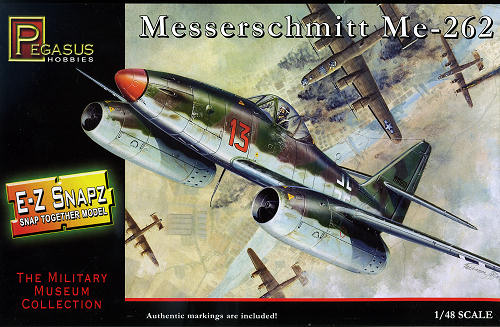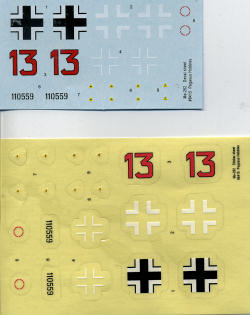
Pegasus Hobbies 1/48 Me-262
| KIT #: | 8415 |
| PRICE: | $10.25 SRP |
| DECALS: | One option |
| REVIEWER: | Scott Van Aken |
| NOTES: | Snap kit with nose weight |

| HISTORY |
Without a doubt, the most successful turbine powered aircraft of the Second World War was the German Me-262. As with all revolutionary vice evolutionary designs, the 262 had its share of delays and problem. Most of these were due to the engines as the airframe was not only relatively conventional, but ready months before any flight ready engines were available.
Originally designed for the BMW 003 axial-flow turbojet engine, massive problems with the BMW design (mostly due to problems associated with metallurgy in the hot section), had the designers switch to the larger, but closer to ready Junkers Jumo 004.
Once the aircraft and engines were mated and somewhat reliable enough to do test flights, the improvement in performance was remarkable. An often quoted comment by Adoph Galland after he flew the plane was that it was"...like angels were pushing." The speed advantage of the 262 was often at least 100mph above what a piston engined aircraft was able to reach.
However, there were disadvantages. One was that there was no real throttle response. The pilot had to be very careful increasing or decreasing throttle settings or the engines would lose power and flame out, or quit. While the 262 could fly on one engine and glide well if both were inoperable, it had lost its speed advantage. Most 262s were shot down during landing, takeoff or during single engine operation after one had been damaged. The majority of 262 losses were in various accidents not directly related to combat. It wasn't a plane where one could hop out of a 109 or 190 and go right into flying the 262.
The engines also had very short life; initially 10 hours or less, though by the end of the war that had crept up to 25-30 operating hours. Other problems beset the 262 as well as other aircraft from lack of quality materials, rushed production, and a host of other ills as a result of the lack of centralized production. New pilots got very little training thanks to constant Allied air attacks and the general paucity of fuel. Though the 262 burned low grade kerosene, even that was in short supply in the last months of the war.
However it was a milestone aircraft in the annals of aviation. Just the threat of the aircraft was enough for the Allies to expend excess time, materiel and energy to try to blunt. Fortunately for us, there are over a dozen complete airframes in various museums around the world where we can see this famous and ground-breaking aircraft. Those wishing to know more about this aircraft only need to enter 'Me-262' into any of the various search engines. There will be a staggering number of websites listed that are devoted in one way or another to the 262.
| THE KIT |
 Let
me preface the kit description by stating that this is a snap kit, designed for
new modelers and as such, the parts are not fiddly and are rather robust. This
also means that there are not things like separate gear doors, separate gear
legs and sometimes wheels are molded on the gear/door piece. These are, for lack
of a description, designed to actually be played with, therefore the robust
construction.
Let
me preface the kit description by stating that this is a snap kit, designed for
new modelers and as such, the parts are not fiddly and are rather robust. This
also means that there are not things like separate gear doors, separate gear
legs and sometimes wheels are molded on the gear/door piece. These are, for lack
of a description, designed to actually be played with, therefore the robust
construction.
Having said that, the kit is very nicely molded. The engraved
and raised detail is quite good though the former is a bit heavy (sort of like a
Matchbox kit). The kit includes a nose weight to keep it from tail sitting.
There is a very basic interior that has no control stick and only has a slot in
instrument panel. There is a somewhat thick, one-piece canopy that snaps into
place. There are separate gear doors for those who want to build the model gear
up. This will provide enhanced play realism as no 262 flew
 missions with
the gear down. Under the wings there are R4M rockets. The mounts are molded in
place so if you are doing a plane that didn't fly in the last month or so of the
war, you have a lot of sanding to do. The mass of rockets are separate. For
those wondering, you can see the underside of the cockpit tub through the main
wheel wells, but there is no detail.
missions with
the gear down. Under the wings there are R4M rockets. The mounts are molded in
place so if you are doing a plane that didn't fly in the last month or so of the
war, you have a lot of sanding to do. The mass of rockets are separate. For
those wondering, you can see the underside of the cockpit tub through the main
wheel wells, but there is no detail.
Instructions are very well drawn and clearly show where all the bits go. There is no painting information in the construction process. Markings are provided as both standard water slide decals and as stickers. They are for Heinz Bar's plane and instructions would have you paint it RLM 81/83 on the upper surfaces with RLM 78 on the underside. Clearly this last is a glitch and it should be RLM 76. The decals are well printed and, of course, are lacking a swastika. A note suggests painting the interior RLM 02 (it should be RLM 66) and the instrument panel flat black (it should also be RLM 66).
| CONCLUSIONS |
| REFERENCES |
February 2011
Thanks to me for getting this one.
If you would like your product reviewed fairly and quickly, please contact me or see other details in the Note to Contributors.
Back to the Previews Index Page
Back to the Reviews Index Page